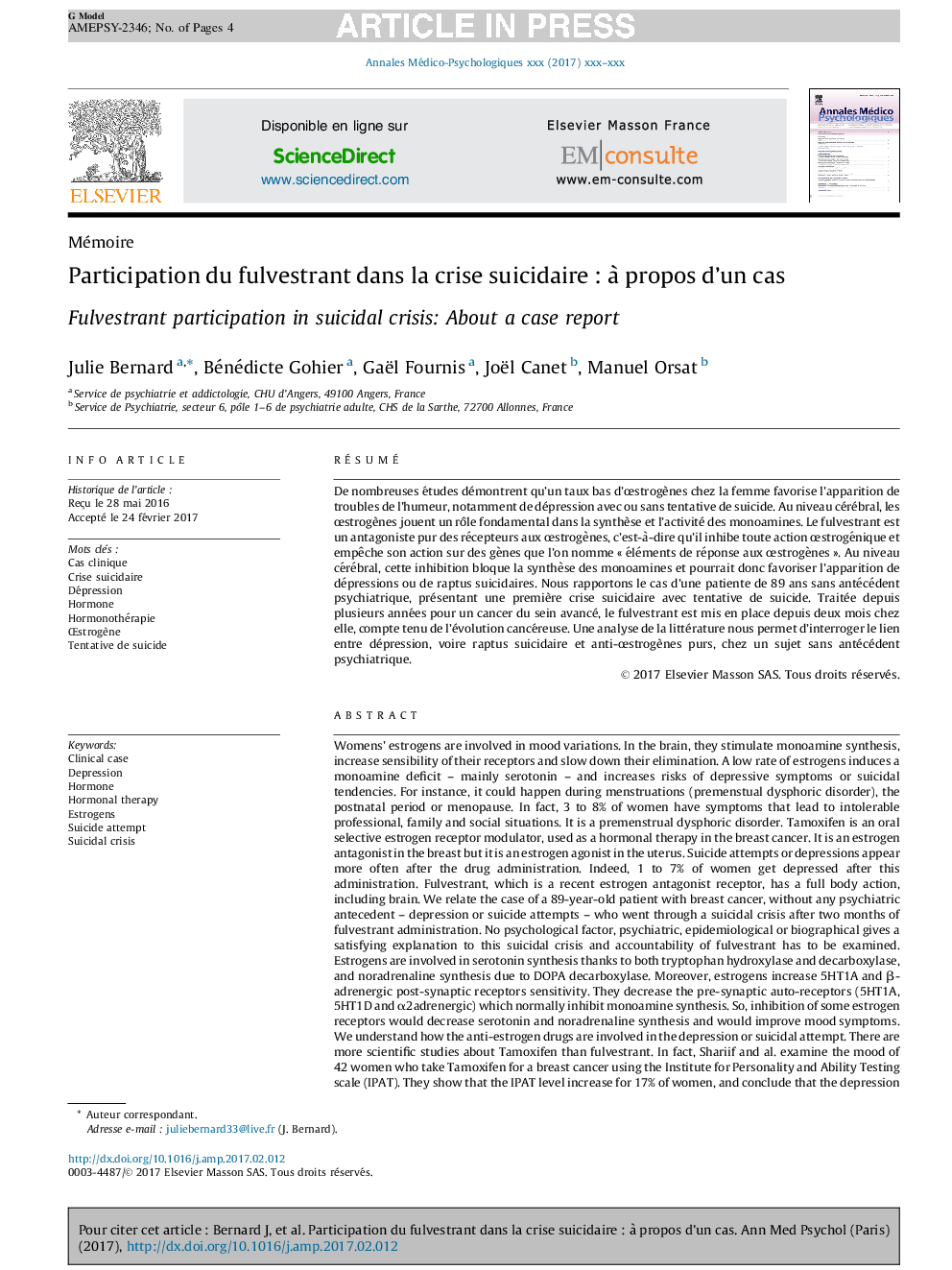| کد مقاله | کد نشریه | سال انتشار | مقاله انگلیسی | نسخه تمام متن |
|---|---|---|---|---|
| 6785154 | 1432368 | 2018 | 4 صفحه PDF | دانلود رایگان |
عنوان انگلیسی مقاله ISI
Participation du fulvestrant dans la crise suicidaire : à propos d'un cas
دانلود مقاله + سفارش ترجمه
دانلود مقاله ISI انگلیسی
رایگان برای ایرانیان
کلمات کلیدی
موضوعات مرتبط
علوم پزشکی و سلامت
پزشکی و دندانپزشکی
روانپزشکی و بهداشت روانی
پیش نمایش صفحه اول مقاله

چکیده انگلیسی
Womens' estrogens are involved in mood variations. In the brain, they stimulate monoamine synthesis, increase sensibility of their receptors and slow down their elimination. A low rate of estrogens induces a monoamine deficit - mainly serotonin - and increases risks of depressive symptoms or suicidal tendencies. For instance, it could happen during menstruations (premenstual dysphoric disorder), the postnatal period or menopause. In fact, 3 to 8% of women have symptoms that lead to intolerable professional, family and social situations. It is a premenstrual dysphoric disorder. Tamoxifen is an oral selective estrogen receptor modulator, used as a hormonal therapy in the breast cancer. It is an estrogen antagonist in the breast but it is an estrogen agonist in the uterus. Suicide attempts or depressions appear more often after the drug administration. Indeed, 1 to 7% of women get depressed after this administration. Fulvestrant, which is a recent estrogen antagonist receptor, has a full body action, including brain. We relate the case of a 89-year-old patient with breast cancer, without any psychiatric antecedent - depression or suicide attempts - who went through a suicidal crisis after two months of fulvestrant administration. No psychological factor, psychiatric, epidemiological or biographical gives a satisfying explanation to this suicidal crisis and accountability of fulvestrant has to be examined. Estrogens are involved in serotonin synthesis thanks to both tryptophan hydroxylase and decarboxylase, and noradrenaline synthesis due to DOPA decarboxylase. Moreover, estrogens increase 5HT1A and β-adrenergic post-synaptic receptors sensitivity. They decrease the pre-synaptic auto-receptors (5HT1A, 5HT1D and α2adrenergic) which normally inhibit monoamine synthesis. So, inhibition of some estrogen receptors would decrease serotonin and noradrenaline synthesis and would improve mood symptoms. We understand how the anti-estrogen drugs are involved in the depression or suicidal attempt. There are more scientific studies about Tamoxifen than fulvestrant. In fact, Shariif and al. examine the mood of 42 women who take Tamoxifen for a breast cancer using the Institute for Personality and Ability Testing scale (IPAT). They show that the IPAT level increase for 17% of women, and conclude that the depression risk increase. However, scientific studies do not often mention psychiatric effects of the partial antagonist estrogen receptor, such as fulvestrant. This pure estrogen antagonist receptor acts homogeneously in the whole body. It prevents the link between the estrogen and their genes (“estrogen response elements”), which are involved in monoamine synthesis. It acts as an anti-estrogen that binds to and degrades the estrogen receptor. It has an estrogen antagonistic activity but no estrogen agonistic effect. In the brain, the Fulvestrant has a potent inhibition action on monoamine synthesis. With fulvestrant, no estrogen can influence monoamine synthesis. Its effects are probably more powerful than Tamoxifen is. So, it boosts the appearance of depression or suicide. Neurobiological effects of fulvestrant are known. They can be explained by estrogen inhibition and they can explain the suicidal crisis. Therapeutic trials of anti-estrogen hormonal therapy have to include a psychiatric evaluation about suicidal risk. Moreover, a better knowledge of neurobiological effects of endocrine therapy would avoid complications and may allow to inform physicians and patients on psychiatric side effects of those therapies.
ناشر
Database: Elsevier - ScienceDirect (ساینس دایرکت)
Journal: Annales Médico-psychologiques, revue psychiatrique - Volume 176, Issue 5, May 2018, Pages 434-437
Journal: Annales Médico-psychologiques, revue psychiatrique - Volume 176, Issue 5, May 2018, Pages 434-437
نویسندگان
Julie Bernard, Bénédicte Gohier, Gaël Fournis, Joël Canet, Manuel Orsat,